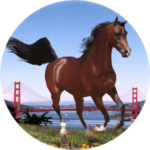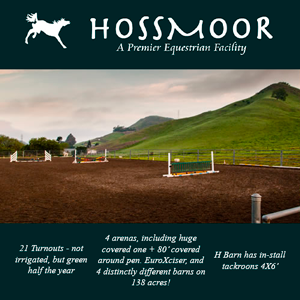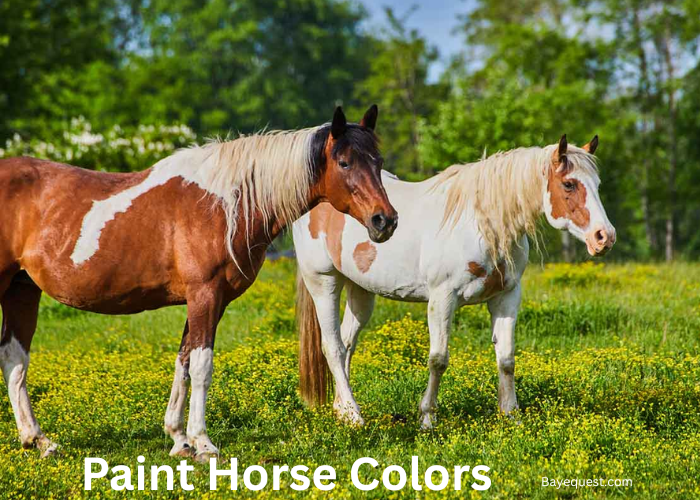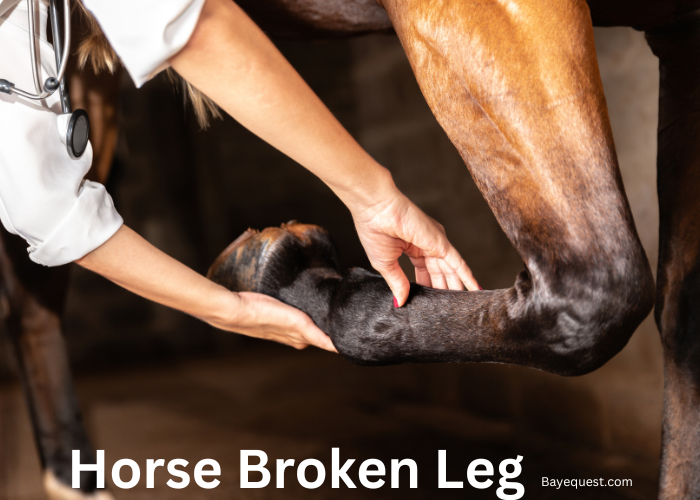Paint Horses turn heads and leave people staring. Their coats are a wild mix of color, pattern, and personality.
No two are ever the same. Some look like living artwork, with bold splashes of white and dark patches.
Others carry soft, smoky shades with just a hint of mystery. But there’s more to these horses than just looks.
Every mark has a name. Every pattern tells a story. In this blog, we’ll break down the colors, patterns, and what makes each Paint Horse truly one of a kind.
Let’s dive into their world of color.
Paint Horse Colors: Key Takeaway
Paint Horse colors come in bold patterns like Tobiano, Overo, Tovero, and Sabino. These patterns appear over base colors such as bay, black, chestnut, and buckskin. Each Paint Horse has a unique look. Their colors are shaped by genetics, making them one of the most eye-catching horse breeds today.
What is a Paint Horse?
A Paint Horse is a colorful, eye-catching breed with bold coat patterns and strong, athletic build. It’s a registered breed with the American Paint Horse Association (APHA) and combines the best traits of Western stock horses.
What sets Paint Horses apart are their distinct coat patterns: Tobiano, Overo, and Tovero. These patterns feature striking mixes of white and dark base colors.
But it’s not just about looks. Paint Horses are smart, versatile, and gentle, making them great for everything from rodeo to trail riding.
Pros and Cons of a Paint Horse
Here’s a breakdown of the pros and cons of owning a Paint Horse:
Pros of a paint horse
Striking appearance. Their unique coat patterns stand out in any crowd.
Friendly temperament. Most Paint Horses are calm, social, and easy to handle.
Versatile use. Great for Western riding, trail rides, ranch work, and even jumping.
Intelligent and trainable. They learn quickly and respond well to consistent training.
Strong build. Muscular and sturdy, ideal for both work and pleasure.
Cons of a paint horse
Genetic risks. Some carry the lethal white overo gene (OLWS), which affects foals if both parents have it.
Sun sensitivity. White patches, especially around the face, can burn in strong sun and need extra care.
Show horses require higher maintenance. If showing, keeping the coat clean and markings bright can be a full-time job.
Not always budget-friendly. Eye-catching color can raise the price tag, especially for registered horses.
Paint Horse History and Origins
The Paint Horse’s roots run deep in American soil. Their story begins long before the breed was officially recognized.
Spanish explorers brought colorful horses with white markings to the Americas in the 1500s.
Native American tribes, especially the Comanche, prized these flashy horses for their beauty, strength, and spirit.
As settlers moved west, these horses were bred with hardy ranch horses like Quarter Horses and Thoroughbreds. The result? A tough, intelligent, and eye-catching animal that could handle work, war, and travel.
In 1965, the American Paint Horse Association (APHA) was formed to preserve and promote these uniquely marked horses.
Since then, the Paint Horse has become one of the most popular breeds in the U.S., known not just for looks but for heart and grit.
Paint Horse Coat Genetics
Paint Horse coat patterns come from a mix of base colors and pattern genes.
The base color might be black, bay, chestnut, or something rarer like palomino or buckskin. But what makes Paint Horses special are the white pattern genes layered on top.
There are three main pattern types; Tobiano, Overo, and Tovero. These patterns are passed down through dominant or recessive genes.
For example, Tobiano is a dominant gene. If a horse inherits just one Tobiano gene from either parent, it will usually show the Tobiano pattern.
Overo patterns, on the other hand, are more complex and can hide for a generation, then pop up unexpectedly.
One important gene to know is the frame overo gene, which can carry a risk.
If two horses with this gene are bred, the foal may inherit lethal white syndrome (OLWS). That’s why responsible breeders often run genetic tests before breeding Paint Horses.
In short, a Paint Horse’s coat is no accident. It’s a fascinating blend of color, pattern, and genetics.
Characteristics of a Paint Horse
Paint Horses are bold, muscular, and beautifully built with a balanced frame, deep chest, and strong hindquarters.
They stand between 14.2 and 16 hands tall, with clean legs, tough hooves, and expressive faces that show alertness and curiosity.
They are intelligent, gentle, and easy to train, making them great partners for beginners and experienced riders alike.
Calm in nature and quick to learn, they adapt well to different tasks, whether it’s trail riding, ranch work, or spending time with their rider.
Paint Horses are dependable, hardworking, and full of personality, both on the ground and in the saddle.
Main Paint Horse Color Patterns
Paint Horses come in various patterns, but the four most recognized are Overo, Tobiano, Tovero, and Sabino. Let’s find out what sets them apart.
Overo pattern
Overo horses usually have dark bodies with bold, uneven white markings. The white patches often appear on the sides, belly, or face, but rarely cross over the horse’s back.
These markings have jagged or splashy edges, giving the coat a dramatic look. Overos often have blue eyes and distinctive face patterns, like bald or apron faces.
One type, called Frame Overo, carries a genetic risk. When two are bred together, their foal could inherit lethal white syndrome (OLWS).
Tobiano pattern
Tobiano horses have white patches that are smoother and more rounded, often resembling large spots or ovals.
These white areas usually cross the horse’s back, running from one side to the other. Tobianos tend to have white legs and a darker face.
This pattern gives a more balanced, symmetrical look, and it’s one of the easiest patterns to recognize.
Because the Tobiano gene is dominant, it often shows up clearly in Paint Horse offspring.
Tovero pattern
Tovero horses are a mix of both Tobiano and Overo. Think of them as hybrids, blending traits from each other.
You might see a mostly white horse with dark patches around the ears, eyes, chest, or flanks.
Some have dark rings around the mouth or one dark ear, while others have blue eyes and a bold “shield” on the face. No two Toveros look the same, they’re full of surprises.
Sabino pattern
Sabino is a softer, more scattered pattern. It often looks like roaning or lace-like white on the legs, belly, and face.
The edges of the white areas tend to be feathered or speckled rather than sharp.
Some Sabinos have wide face markings, white chins, or high stockings, while others appear almost solid until you spot the fine roaning across the coat.
Common Base Colors in Paint Horses
The paint pattern sits on top of a horse’s base color, and that’s what makes each Paint Horse unique.
Whether the pattern is Tobiano, Overo, or something in between, the base color plays a big role in how bold or soft the markings appear.
Here are the most common base colors found in Paint Horses and how they interact with coat patterns:
Bay
Bay is one of the most common base colors. It features a reddish-brown body with black mane, tail, and lower legs.
When combined with white paint patterns, the deep reddish color creates strong contrast.
On a bay Tobiano, for example, white patches stand out boldly against the rich coat, while the black legs often remain visible under the white.
Black
Black is striking on its own, but when paired with paint markings, it becomes even more dramatic.
White patches over a black base create sharp contrast, giving the horse a bold, high-impact look.
This color makes patterns like Overo especially eye-catching, with crisp, white markings cutting across the dark body.
Chestnut/Sorrel
Chestnut (also called Sorrel) is a reddish-gold color with no black points. It ranges from light copper to deep liver red.
White paint patterns over a chestnut base often appear softer than on black or bay horses. Still, the contrast is beautiful, especially when combined with a bright white face marking or socks.
Buckskin
Buckskin horses have a golden coat with black points, mane, tail, and legs. When paint patterns layer over this base, the result is eye-catching and warm-toned.
A Tobiano or Tovero buckskin can look almost golden-white, especially under sunlight, and the black mane and tail make the contrast even richer.
Related read: Similarities of Buckskin and Dun Horse?
Palomino
Palominos have creamy gold coats and white or light-colored manes and tails. When combined with paint patterns, the contrast is softer and more blended.
White patches on a Palomino may not pop as much as they do on darker bases, but they create a smooth, golden glow that many riders love.
Gray
Gray Paint Horses are born with a solid base color like black or bay, but they lighten over time.
Their coat gradually fades to white or silver, so the paint pattern may become harder to see with age.
Early in life, the white patches and base color are clearly defined, but as the horse grays out, the markings often blend into the rest of the coat.
Rarer Paint Horse Colors
While most Paint Horses have common base colors like bay or chestnut, some come in rarer shades that add even more visual appeal.
These unusual colors, combined with paint patterns, make for unforgettable horses. Here are a few of the most eye-catching rare colors:
Grullo
Grullo, also called “blue dun”, is a smoky, mouse-gray color with black points. The mane, tail, and legs often have a dorsal stripe down the back. The color comes from a black base diluted by the dun gene.
When mixed with white paint markings, the result is a cool-toned, almost metallic look that’s sleek and mysterious.
Read more on Grullo horse colors in our comprehensive article.
Champagne
Champagne horses have a soft, golden, or beige coat with a metallic shine. They often have hazel or amber eyes and freckled or pink skin.
The champagne gene dilutes red or black bases, creating a smooth, velvety finish.
White paint patterns over a champagne coat look refined and elegant, making these horses rare showstoppers.
Cremello
Cremello horses are cream-colored with a pale mane and tail, light blue eyes, and pink skin.
They have two cream genes, which dilute all colors from the coat. Paint markings on a Cremello may be very subtle, blending softly into the body.
They often look like glowing ivory sculptures, especially under natural light.
Can Paint Horses Change Color Over Time?
Yes, some Paint Horses can change color as they age, but not in the way you might think.
The coat pattern itself stays the same, but the base color can shift over time due to genetics, age, and environmental factors. For example, a foal may be born with a darker or fuzzier coat that lightens as it grows.
This is especially common in horses with gray genes, which cause the entire coat to gradually turn white or silver over several years.
Sun exposure can also temporarily lighten the coat, especially in horses with black or dark-colored hair.
This “sun bleaching” can make the horse look more faded in summer, then darker again when new hair grows in.
In rare cases, Paint foals are born with minimal white and develop more visible markings over time. However, most patterns are present at birth and become more defined as the horse matures.
So, while their bold patterns won’t disappear, you might notice slight changes in shading, contrast, or overall brightness as the years go by.
Famous Paint Horses with Striking Paint Colors
Here are a few well-known Paint Horses with colors that turned heads:
1. Pinto Bean
Owned by actor Robert Redford, Pinto Bean had a classic Tobiano pattern and played a key role in Western films.
His crisp white patches and dark bay coat gave him that rugged, all-American cowboy horse look.
2. Colonels Smoking Gun (“Gunner”)
A legend in the reining world, Gunner had a stunning splashy Overo pattern, with a mostly white body, bright blue eyes, and a chestnut base.
He stood out instantly, and backed it up with incredible talent. He became an NRHA Hall of Fame inductee and left a lasting mark as a sire.
3. Versary Bars
One of the earliest stars in the Paint Horse show world, Versary Bars was known for his powerful build and clean Tobiano markings.
His flashy appearance helped boost the breed’s popularity in the 1960s.
4. Apache
Famous for being one of the U.S. Army’s last cavalry horses, Apache was a striking black and white Paint.
His bold coat and brave temperament made him a standout among military mounts.
5. Wahoo King
A champion in halter classes and a cornerstone of Paint Horse breeding, Wahoo King had a sharp, defined Tobiano coat that was the picture of symmetry and balance.
He helped define what a Paint show horse could be.
How to Care for a Paint Horse
Caring for a Paint Horse is similar to caring for any other horse. However, their bold coats may need a little extra attention.
Regular grooming helps keep their white markings clean and their skin healthy, especially around sensitive areas like the face and legs.
Provide clean water, quality hay or pasture, and grain if needed, based on their activity level. Make sure they get regular farrier visits, vaccinations, and dental checks.
Because some Paints have pink skin under white patches, apply sunscreen or use fly masks to prevent sunburn. And above all, give them daily interaction, exercise, and love.
Conclusion
Paint Horses are more than beautiful. They’re full of color, character, and charm.
Each one is a blend of pattern and personality, shaped by both genetics and history. From bold Tobianos to soft Sabinos, no two are exactly alike.
Their base colors add even more depth, making every Paint Horse a true original. Whether you’re drawn to rare shades or classic patterns, there’s a Paint Horse out there that will catch your eye.
Understanding their colors helps you see their story more clearly. And once you do, it’s hard not to fall in love with them.







